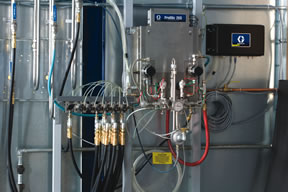June 24, 2014
Simple Ways to Reduce Waste in Your Spray Finishing System
SHARE THIS POST
 In today’s demanding manufacturing landscape, it can be convenient to adopt a “cut-costs-at-all-costs” mentality, justifying questionable means for the sake of leaner production, a lower bottom line and increased profitability. Regrettably, those efforts can interfere with product and process quality, leading to higher scrap rates, costly product recalls and even the loss of valued customers.
In today’s demanding manufacturing landscape, it can be convenient to adopt a “cut-costs-at-all-costs” mentality, justifying questionable means for the sake of leaner production, a lower bottom line and increased profitability. Regrettably, those efforts can interfere with product and process quality, leading to higher scrap rates, costly product recalls and even the loss of valued customers.
Fortunately, in the realm of spray finishing, there are simple solutions that reduce costs while sustaining the integrity of your processes and products. One of the best ways to reduce waste in your spray finishing system and operating costs, and increase efficiency is by reducing the amount of wasted material the system produces.
There are three components which directly contribute to spray waste costs:
1. Material Waste – When spray equipment needs to be cleaned, the leftover material that would typically be used to paint parts is flushed out. That waste material is equal to the total amount of material that the spray equipment holds internally.
2. Solvent Use – Solvent is used to clean material out of the spray equipment. The amount of solvent required depends on how much material is trapped within a system. Typically, the amount of solvent used to flush a system is about 3x the volume of the waste material trapped within the system. When changing the color of material within a system, the amount of solvent used can be up to 6x the volume of the waste material.
3. Waste Disposal – The cost of waste disposal is equivalent to the cost per gallon required to dispose of hazardous materials. This is the combined volume of paint wasted within the system and the total amount of solvent used to clean it.
Material waste costs can get out of hand quickly without proper monitoring and maintenance in place, leading to unnecessary operating costs. Honing in on the material waste in your system can help gauge where your finishing process could improve. While some new equipment may be required, the Return on Investment of a new system quickly offsets the cost.
C. H. Reed integrates and services Graco’s entire line of Plural Component Finishing Systems which are designed to reduce material waste, monitor system efficiency and ensure product quality. With streamlined fluid manifold designs, these systems reduce material waste by eliminating dead spots and reducing the amount of material caught in the system. This, in turn, dramatically lowers the costs of solvent use and waste disposal associated with your system.
Even if you currently use a Graco Plural Component Finishing System, you can upgrade and save on system maintenance, obsolete part replacement and material waste costs with the new, more efficient ProMix 2KS Proportioning System.
Contact one of our specialists today to learn more about improving your spray finishing processes.
(800) 692-7216 ext. 748 solutions@chreed.com
Posted by Clinton Shaffer
Search
Categories
Get a consultation
Related Posts
The 3 Distinct Advantages of Hydraulic Powered Pumps
Recently, C. H. Reed helped a major printing operation install a new ink pumping system. The new system needed to transfer four colors of high viscosity, heat-set ink to their three presses, drawing the ink from multiple 5,000…
Simple Ways to Reduce Waste in Your Spray Finishing System
In today’s demanding manufacturing landscape, it can be convenient to adopt a “cut-costs-at-all-costs” mentality, justifying questionable means for the sake of leaner production, a lower bottom line and increased profitability. Regrettably, those efforts can interfere…
What You Need to Know About Air-Powered Pressure Washers
Pressure washers are great solutions for your average cleaning applications, but what tool do you turn to for your more challenging applications? There are many instances where it is simply impossible to use a traditional…